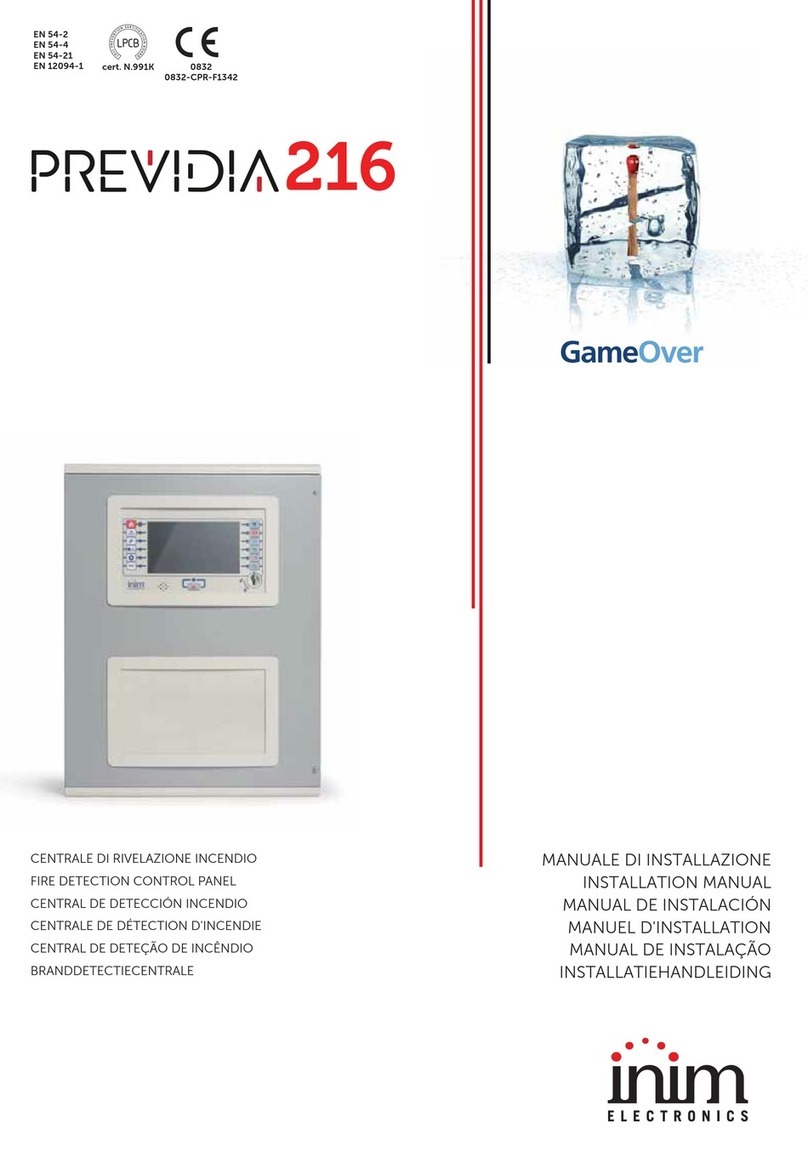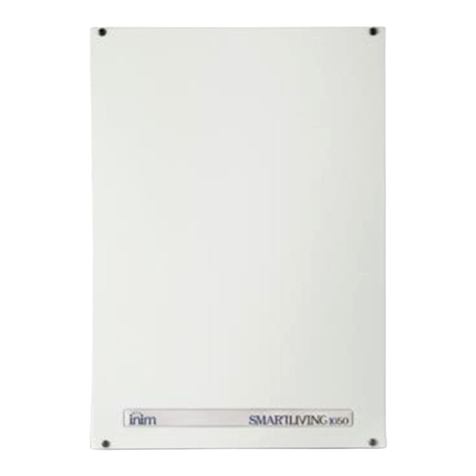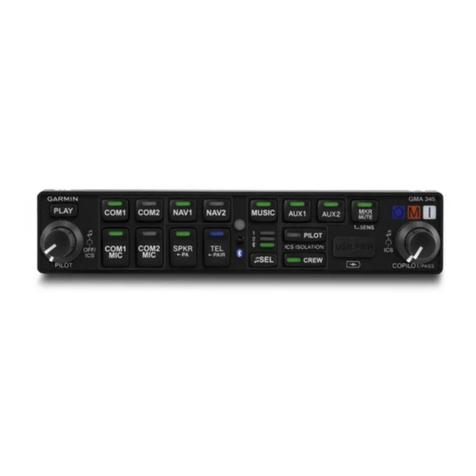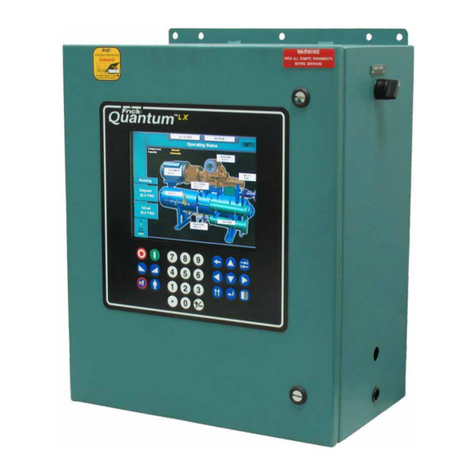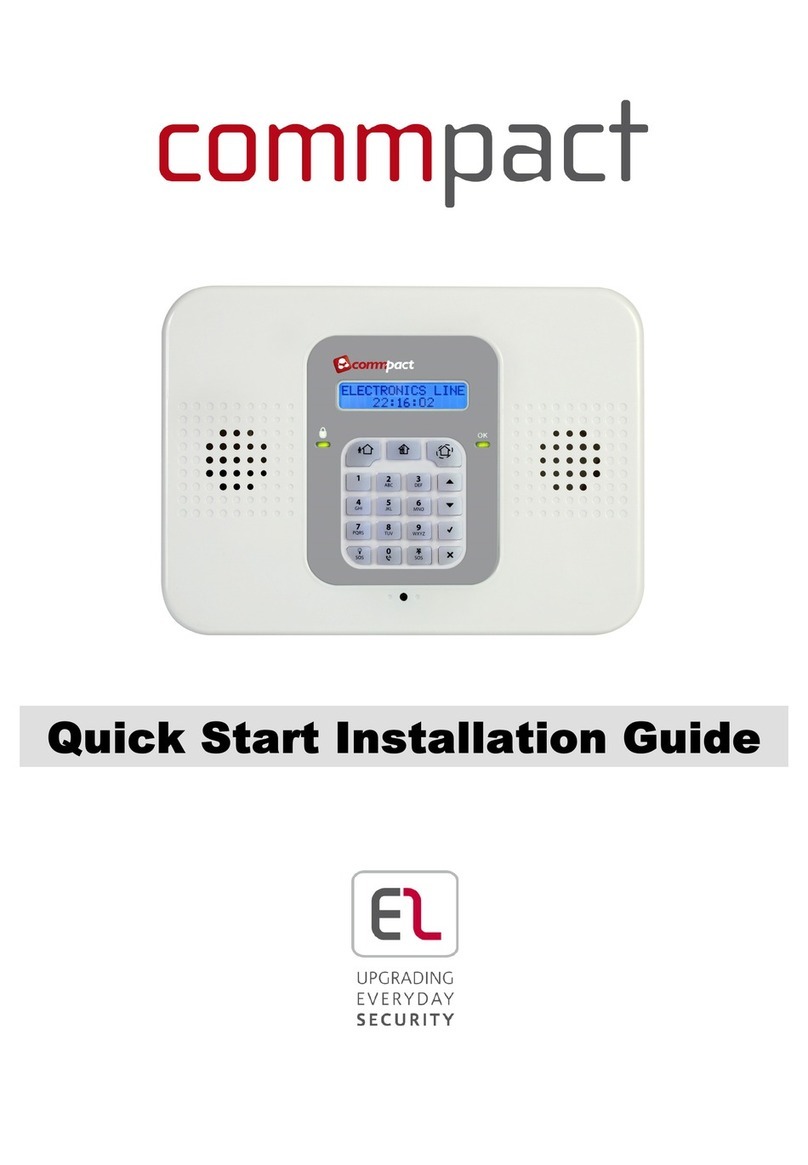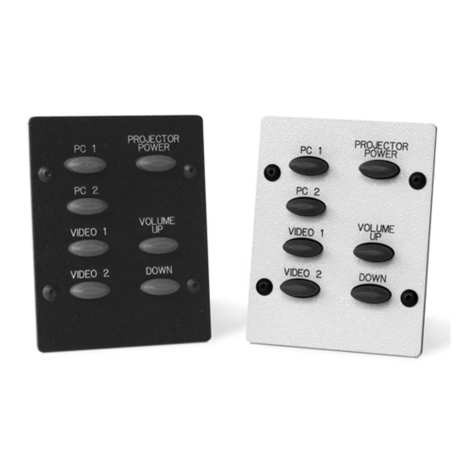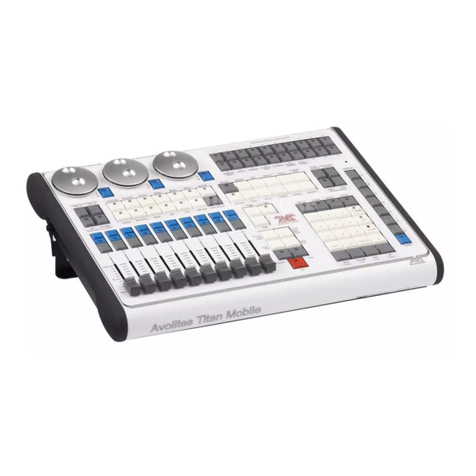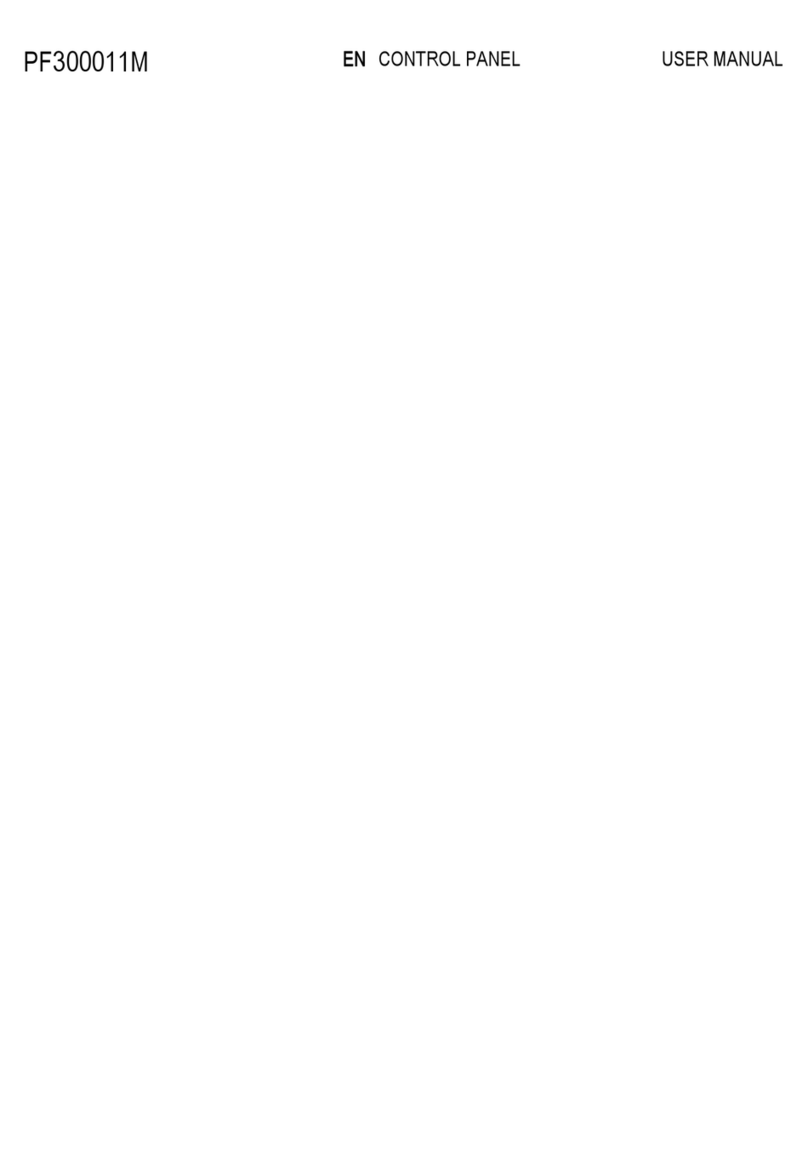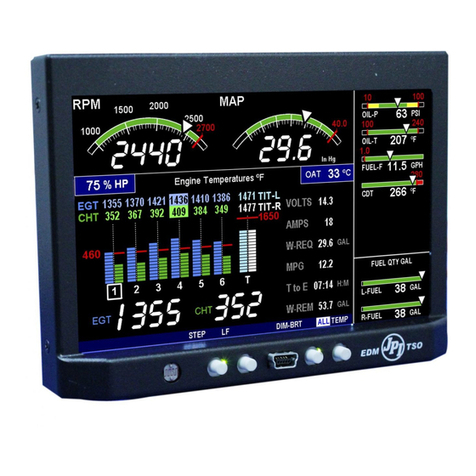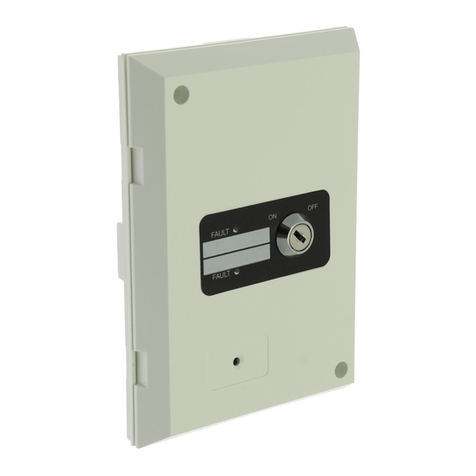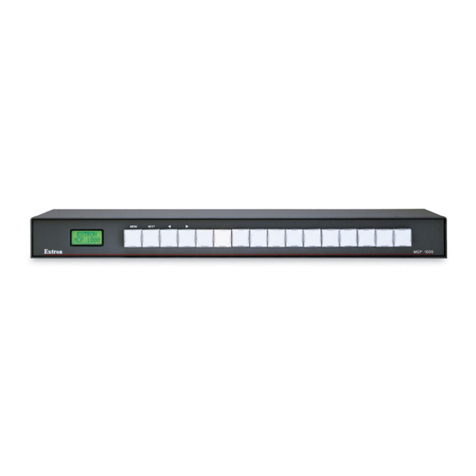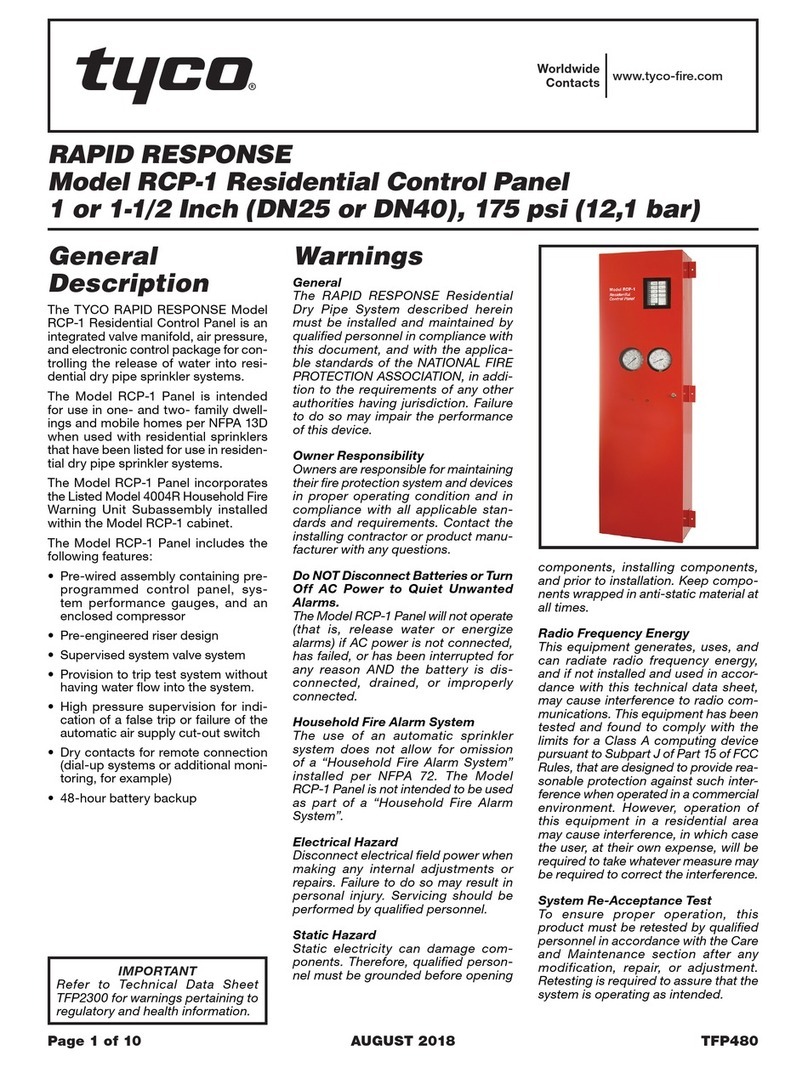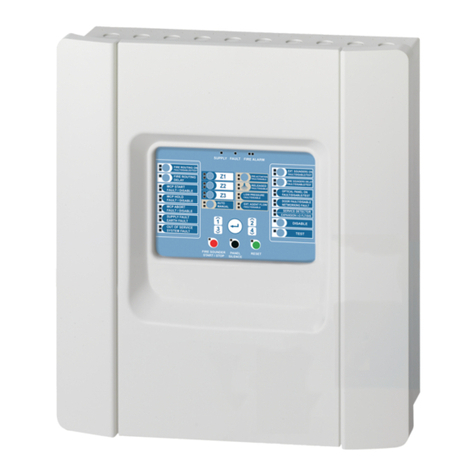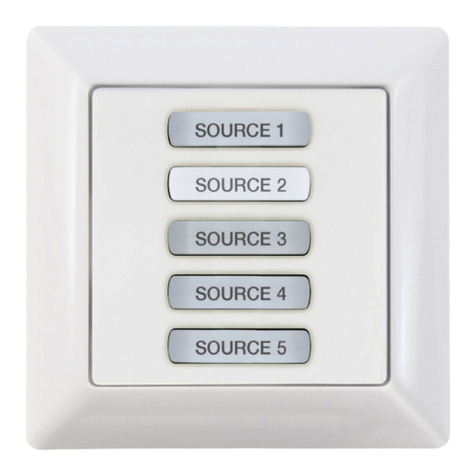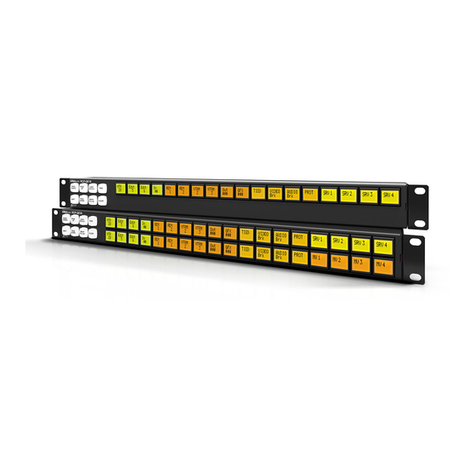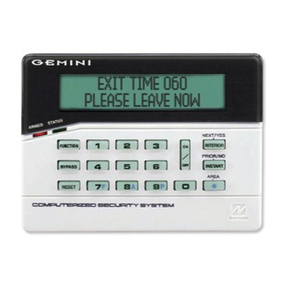INIM Electronics SmartLine Series Assembly instructions

SmartLine
Conventional fire detection control panel
Extinguishant system control panel
Alarm transmission and fault warning routing
equipment with integrated power supply equipment
Installation and programming manual
EN 54-2
EN 54-4
EN 54-21
EN 12094-1
0051
0051-CPR-1412
0051-CPR-1413
0051-CPR-1414

2Copyright
Conventional fire detection control panel
Copyright
The information contained in this document is the sole property of INIM Electronics s.r.l.. No part may be
copied without written authorization from IINIM Electronics s.r.l..
All rights reserved.
European directive compliance
This Control panel has been designed and developed to the highest standards of quality and performance
implemented by INIM Electronics s.r.l..
This control panel must be installed in accordance with the instructions described in this manual and in
compliance with the laws in force.
All control panels from the SmartLine series are EN54-2, EN54-4, EN54-21 and EN12094-1 compliant.
All control panels from the SmartLine series, and all accessory items and special functions have IMQ
Security systems certification, unless otherwise stated.
Declarations of performance, declarations of compliance and certificates relating to the products mentioned
in this manual can be downloaded from the following website:
www.inim.biz

Table of contents 3
Installation and programming manual
Table of contents
Copyright ............................................................................ 2
European directive compliance ............................................... 2
Table of contents.................................................................. 3
Chapter 1 Overview............................................................................. 5
1.1 Application and use 5
1.2 Other parts of the system 7
1.3 The SmartLine fire alarm panel models 7
Chapter 2 General information .............................................................. 8
2.1 Supplied documentation 8
2.2 Manual details 8
2.3 Operator qualifications - access levels 8
2.4 Intellectual property rights 8
2.5 Disclaimer 8
2.6 Recommendations 9
2.7 System test 9
2.8 Note to the installer 9
2.9 Technical support 9
2.10 Conventions 9
2.11 Menu paths 10
2.12 CE Mark 10
2.13 Warranty 11
2.14 Safety laws 11
2.15 Replacement and disposal of used devices 12
Chapter 3 Device management ........................................................... 13
3.1 Product handling and storage 13
3.2 Environmental conditions 13
3.3 Unpacking the device 13
Chapter 4 Technical description........................................................... 15
4.1 Control panel 15
4.2 Internal devices 16
4.3 Technical specifications 18
4.4 PCB current draw 18
Chapter 5 User interface .................................................................... 19
5.1 SmartLine panel frontplate 19
5.2 Repeater (add-on panel) 24
Chapter 6 Installation instructions ....................................................... 27
6.1 Mounting the SmartLine/8Z expansion board (accessory item) 27
6.2 Mounting the SmartLAN/485 Ethernet board (accessory item) 28
6.3 Mounting the SmartLetLoose/ONE extinguishant board (accessory item) 29
6.4 Wall mounting 29
6.5 Connecting the lines 30
6.6 Connecting an alarm dialler 34
6.7 Connecting the dialler for fault communications 34
6.8 Connecting the RS485 BUS 35
6.9 Connecting the fault signalling outputs 37
6.10 Connecting the Alarm signalling output 37
6.11 Connecting NAC outputs to the Smart/8Z expansion board 38
6.12 Connecting AUX and AUX-R outputs 38
6.13 Connecting RELAY output 39
6.14 Connecting the Extinguishant module
(optional system enhancement tool) 39

4Table of contents
Conventional fire detection control panel
6.15 Connecting the mains power source 41
6.16 Connecting the batteries 42
6.17 Thermal probe 43
Chapter 7 Powering up and configuring the system................................ 44
7.1 Testing wiring integrity 44
7.2 Connecting the RS232 PC serial link 44
7.3 Powering up the system 45
Chapter 8 Introduction to Programming from the panel .......................... 46
Chapter 9 Programming from panel ..................................................... 47
9.1 Configuring the control panel 47
9.2 Programming the zones 47
9.3 Setting the Timers 53
9.4 Setting holidays 54
9.5 Setting the control panel options 54
9.6 Setting up equations 55
Chapter 10 Detection line threshold-adjustment...................................... 56
Chapter 11 Programming the extinguishant board ................................... 57
11.1 Configuring the extinguishant module 58
11.2 Programming the module 58
11.3 Programming extinguish inputs/outputs 59
Chapter 12 Configuring the devices connected to the RS485 BUS .............. 60
Chapter 13 Closing the programming session ......................................... 61
13.1 Restoring factory settings 61
Chapter 14 SmartLeague software ........................................................ 62
14.1 Overview 62
14.2 The Solutions 62
14.3 Enable programming via PC 62
Chapter 15 Maintenance ...................................................................... 63
15.1 Set Time and date 63
15.2 Viewing events 63
15.3 Day/Night mode 63
15.4 Bypassing a zone 64
15.5 Bypass the DIALER or ALARM NAC output 64
15.6 Testing the zones 64
15.7 Force the status of I/O lines configured as outputs 64
15.8 Set the date for the next maintenance session 65
15.9 Reading the power supply tension 65
Chapter 16 Diagnostics and fault solutions ............................................. 66
16.1 Fault “Open” 66
16.2 Fault “Shorted” 66
16.3 Repeater faults 66
16.4 Battery faults 66
16.5 Other faults 67
Appendix A Iris devices........................................................................ 68
Notes................................................................................ 71

Installation and programming manual
Overview 5
Chapter 1
Overview
Note:
The control panels described in this manual have been designed and manufactured to the highest standards
of quality, reliability and performance adopted by INIM Electronics. The components selected for these
products will operate properly within their specifications when the environmental conditions outside the
product enclosure comply with Class 3k5 (EN60721-3-3.).
Danger:
The GAS control function is not provided for in the aforesaid standard and therefore cannot
be considered EN54-2 compliant.
Danger:
In order to validate the IMQ-SECURITY SYSTEMS certification, and in compliance with EN54-
2, all the manual alarm buttons and fire detectors employed in the system must be
associated with fire detection and alarm functions.
1.1 Application and use
The SmartLine conventional fire control panel manages up to 20 conventional detector lines (zones) for
SmartLine020 models or up to 36 lines for SmartLine036 model. Each line (zone) accepts up to 30 devices
and is provided with an additional I/O line that can be configured as an open-collector output (the
activation principles can be defined during the configuration phase) or as an independent input line
(separate from the zone) for fire detection, gas detection line, etc. The basic model has 4 on-board zones
(2 for the SmartLine020-2 model) expandable to 20 (or 36 for the SmartLine036) by means of 2
SmartLine/8Z optional attachment boards (8 lines per board).
The control panel also provides a series of outputs for the activation of signalling or remote transmission
devices. The graphic display and LEDs provide visual indication of the system status and real-time
signalling of fault conditions. The control panel supports up to 4 repeater panels (SmartLetUSee/LCD-Lite);
these remote consoles replicate all the information provided by the control panel and allow access to level
1 and 2 functions. The control panel can also house and manage the SmartLetLoose/ONE gas extinguishant
boar (optional).
Figure 1 - Example of a typical SmartLine installation
A
D
C
B
F
E
G

6Overview
Conventional fire detection control panel
[A] The zones
Each zone is provided with a pair of terminals (lines) for the connection of the fire-detection devices
deployed in the protected area. Each line (zone) accepts up to 30 devices (conventional detectors or call
points). The control panel can be configured to discriminate between detector and call point triggered
alarms. Each line can be configured to activate various signals (fire alarm, gas alarm, etc.).
The lines accommodate:
•Detectors: A detector is an active fire protection device that detects smoke or flames and issues an
alarm thereby alerting building occupants to the danger of fire. They can be:
- Optical smoke detectors which look for the presence of visible by-products of combustion in the
detection chamber (Tyndall effect).
- Optical/Heat detectors which operate as per optical smoke detectors but also sense for increase in the
environment temperature. The combination of both sensing methods (smoke and heat) provides faster
detection and reduces the false alarm rate.
- Heat detectors which sense for an increase in the temperature in the protected environment. These can
be either fixed temperature detectors (which generate an alarm signal when the ambient temperature
exceeds the pre-set temperature threshold) or rate-of-rise (which respond to a rapid rise in
temperature.
- Ionization smoke detectors: feature a harmless radioactive source within a dual detection chamber.
They operate by sensing for a change in electrical conductivity across the detection chamber.
- CO detectors: sense the levels of carbon monoxide given off by all carbon-based materials in the
smouldering stages of a fire (often combined with heat detection sensor).
•Conventional call point: a clearly indicated fire button with instructions for use in the event of fire.
This device is usually located in strategic positions especially near building entry/exit points. When
activated these devices trigger system alarms.
For further information regarding the list of the detectors the lines accommodate, and for details regarding
their operating principles, refer to Chapter 10 - Detection line threshold-adjustment.
Danger:
In order to comply with EN54-2 requirements, no more than 30 detectors/devices should be
connected to each line.
Each detection line must be terminated with a 3900 ohm resistor (included), in such way as to allow the
control panel to monitor the integrity of the wiring.
[B] SmartLetUSee/LCD-Lite repeater (accessory item)
This optional system enhancement tool (equipped with keypad, LEDs, fast buttons and display) replicates
all the system data. The control panel manages up to 4 repeaters which can be connected at a distance of
up to 1000m from the control panel via RS485 BUS. These devices are usually located near building entry/
exit points in order to allow personnel to obtain information regarding zones affected by alarm conditions
without actually entering the premises.
[C] SmartLevel power supply station (accessory item)
The SmartLevel is the ideal power source for all devices located in the area protected by the fire detection
system. Its internal board meets all EN54 requirements and provides complete supervision of the power
station. The device can be connected to the control panel by means of the RS485 BUS, thus allowing the
complete supervision of the power station and control of the 3 outputs.
[D] Gas extinguishant system (accessory item)
The panel can house and manage a gas extinguishant module (SmartLetLoose/ONE, optional system
enhancement board). The gas extinguishant module is compliant with EN 12094-1.
[E] Sounderflashers
These audible/visual alarm signalling devices connect to the control panel outputs and are capable of
signalling specific conditions. The activation trigger (alarm, pre-alarm, warning, etc.), can be specified
during the system configuration session.

Installation and programming manual
Overview 7
[F] SmartLink Advanced telephone dialler
INIM's SmartLink/G and SmartLink/GP telephone dialers monitor the analogue landline and, in the event of
landline problems (line cutting, etc.) divert incoming and outgoing calls to the GSM network. The
SmartLink/P model operates solely over the PSTN line (landline).
[G] SmartLAN/485 Ethernet connection board (accessory item)
Allows the control panel to connect to an Ethernet network for remote connection. So it is possible to
modify the configuration parameters (up-download programming data) and/or manage the system using
the SmartLook supervision software based on graphical maps.
1.2 Other parts of the system
Zone: a group of points (detectors, etc.) connected to a detection line. The control panel provides an extra
terminal (I/O) for each zone. If the terminal (I/O) is configured as an input, the control panel will be able to
split the detection line of each zone. This feature can be used when zones require a detector line that is
separate from the call point line in order to ensure proper operation of one line in the event of fault on the
other.
Switching power supply: this unit, starting from the mains power supply (230V ) it connects to,
supplies the board with a 24V (27.6V ) stabilized current capable of feeding the control panel and
recharging the batteries. The EN54-4 compliant power-supply module is housed below the motherboard.
the mains power supply (230V ) the primary power source of the system. Refer to paragraph 4.2 -
Internal devices.
Batteries: the secondary power source of the system. The panel enclosure houses two lead batteries @
12V 17Ah (connected in series). The system monitors the battery status (efficiency and charge). In the
event of inefficient or low battery conditions, the system will signal battery fault. In the event of primary
power failure (230V ), the batteries will take over automatically. If the problem persists for a long period
thus causing the battery charge to drop below the minimum value required, they will be shutdown
automatically in order to avoid damage. Refer to paragraph 6.16.
Thermal probe: an accessory tool, to be connected to the panel and attached to the battery pack. This
device monitors the temperature of the external battery pack and regulates the battery charge accordingly.
Refer to paragraph 6.17.
RS485 BUS: 4 wire BUS for the repeater connections. Cabling must done with 4 pole braided shielded
cable. Refer to paragraph 6.8 - Connecting the RS485 BUS.
Timer: a logical entity (the panel provides 8 timers) for automatic time-management of preset intervals (2
intervals per day) on preset days of the week and specific dates. The timers can be used in equations to
manage predefined operations or activate outputs.
Equation: a group of logical conditions defined by the installer. An equation comprises a series of
operators (AND, OR, +, etc.) and a series of operands (Points, Zones, Timers, etc.). An equation can be
associated with an output that will activate when the equation is satisfied.
Holidays: a list of days defined during the system configuration session which are associated with the
control panel timers.
1.3 The SmartLine fire alarm panel models
The available models are:
• SmartLine020-2 - Conventional fire alarm control panel with 2 zones non expandable
• SmartLine020-4 - Conventional fire alarm control panel with 4 zones expandable to 20
• SmartLine036-4 - Conventional fire alarm control panel with 4 zones expandable to 36

8General information
Conventional fire detection control panel
Chapter 2
General information
2.1 Supplied documentation
• Installation and programming manual (this manual)
• User's manual
The Installation manual is inside the device package. For further copies of the Installation Manual, please
contact INIM electronics offices.
2.2 Manual details
• Title: SmartLine installation and programming manual
• Version: 3.60
• Manual code: DCMIINE0SLINE
• Addresses: installer, technicians
2.3 Operator qualifications - access levels
The SmartLine is EN-54 compliant. There are four access levels:
Level 1: The Public
All persons in the building can view the system status (active events) and events log; silence
the panel beeper and, under pre-alarm conditions, override pre-alarm status and activate an
instant alarm.
Level 2: Authorized operators — person/s responsible for the safety of the building and its occupants.
Authorized operators (keyswitch and PIN users) can silence the outputs, reset the panel,
activate the 'Investigation' delay, disable zones, points and outputs, change the operating mode
(Day/Night) and activate the 'Evacuation' alarm.
Level 3: Authorized technicians appointed by the Installer company.
Such technicians possess the tools required for the removal of the control panel frontplate. And,
are allowed to insert the jumper which enables the control panel programming phase (via
control panel or PC), in order to access the programming and maintenance functions. The
control panel is unable to process data or generate fault or alarm signals of any kind during the
programming phase.
Level 4: Technicians employed by the Manufacturer (INIM Electronics s.r.l.).
The manufacturer company technicians can, by means of special tools, repair or replace the
control panel components.
Note:
This manual is for Authorized installer company technicians (Level 3). However, it also provides some
installation information related to level 1 and level 2.
2.4 Intellectual property rights
The information contained in this document is private property. All rights reserved.
This document must not be reproduced, either totally or in part, without the prior written consent of INIM
Electronics, and refers to the devices specified in paragraph 2.12.
2.5 Disclaimer
INIM Electronics s.r.l. shall not be responsible for damage arising from improper application or use.
This control panel should be handled by qualified personnel only. Installation must be carried out strictly in
accordance with the instructions described in this manual, and in compliance with the local fire code in force.

Installation and programming manual
General information 9
2.6 Recommendations
INIM Electronics recommends that the entire system be checked completely at regular intervals (refer to
paragraph 2.7 - System test).
2.7 System test
This system has been designed to provide the highest standards of reliability and performance. Malfunction
of any of the system devices may cause the system to be incapable of reaching the intended levels of
performance. Most problems which prevent the system from operating as intended can be found by regular
testing and maintenance of the system devices (refer to Chapter 15 - Maintenance).
The test must include all the system detectors, signalling devices and all other devices that are part of the
system.
2.8 Note to the installer
In order to provide adequate protection and instructions for correct use of the apparatus, you (the
installer) must be fully aware of the regulations and operating procedures of firefighting. As the only
individual in contact with system users, it is your responsibility to instruct them on how to use this system
properly and to bring to their attention that every fire is different in the amount of smoke and rate of
burning. Therefore, smoke and heat detectors may not provide timely warning of fires caused by violent
explosions, escaping gas or improper storage of inflammable materials.
Regardless of its capabilities, a fire alarm system is not a substitute for the necessary precautions building
occupants must take to prevent or minimize the harmful effects of fire.
2.9 Technical support
Our professional engineers are readily available to assist you. If you require help, call us and you will be
put through to a person capable of answering your questions and providing you with the service you need.
2.10 Conventions
2.10.1 Terminology
Panel; device; system: refer to the devices defined in paragraph 2.12.
Left, right, behind, above, below: refer to the directions as seen by the operator in front of the mounted
device.
Communicator (telephone, SMS, digital):synonym of dialler.
STP: Shielded twisted pair cable.
Qualified personnel: those persons whose training, expertise and knowledge of the laws and bylaws
regarding service conditions and the prevention of accidents, are able to identify and avoid all possible
situations of danger.
Select: click on and select a specific item (from drop-down menu, options box, graphic object, etc.).
Press: click on a video button, or press a key on the panel keypad.
2.10.2 Graphic conventions
Following are the graphic conventions used in the text. For a description of the graphic conventions relating
to the interface, refer to paragraph 5.1 - SmartLine panel frontplate.
Conventions Example description
Text in Italics Refer to paragraph 2.10.2
- Graphic conventions
Text in italics: indicates the title of a chapter, section, paragraph,
table or figure in this manual or other published reference.
<text> #<CustomerCode> Variable data.
[uppercase letter]
or [number]
[A] or [1] Identifies a system component or video object.
BUTTON Esc, RESET Computer or control panel keys.

10 General information
Conventional fire detection control panel
Note:
The detached notes contain important information about the text.
Attention:
The attention prompts indicate that total or partial disregard of the procedure could damage
the connected devices.
Danger:
The danger warnings indicate that total or partial disregard of the procedure could injure the
operator or persons in the vicinity.
2.11 Menu paths
Example
From panel: <key>, Programming, Progr. zone, select a zone, Ok
Via software application: Control panel, Zones
Access to specific functions can be achieved by using the panel keys or PC video objects and the respective path.
Note:
This manual describes the recommended programming flow.
Attention:
For most part this manual describes programming from the control panel.
2.12 CE Mark
Figure 2 - Certifications for SmartLine control panels
Note:
The indications for the CE marking shown in the installation manual of the SmartLetLoose/ONE electronic
board (optional accessory device) are an integral part of the indications shown here on condition that it is
installed in the mentioned control panels.
Declarations of performance, declarations of compliance and certificates relating to the products mentioned
in this manual can be downloaded from the following website:
www.inim.biz
0051
EN 54-2:1997 + A1:2006
EN 54-4:1997 + A1:2002 + A2:2006
EN 54-21:2006
SmartLine020-2
Control and indicating equipment with integrated power supply
equipment and alarm transmission and fault warning routing
equipment for fire detection and fire alarm systems installed in
buildings
INIM ELECTRONICS S.R.L.
via Dei Lavoratori 10 - fraz. Centobuchi
63076 Monteprandone (AP) - Italy
18
0051-CPR-1414
0051
EN 54-2:1997 + A1:2006
EN 54-4:1997 + A1:2002 + A2:2006
EN 54-21:2006
SmartLine036-4
Control and indicating equipment with integrated power supply
equipment and alarm transmission and fault warning routing
equipment for fire detection and fire alarm systems installed in
buildings
INIM ELECTRONICS S.R.L.
via Dei Lavoratori 10 - fraz. Centobuchi
63076 Monteprandone (AP) - Italy
18
0051-CPR-1412
0051
EN 54-2:1997 + A1:2006
EN 54-4:1997 + A1:2002 + A2:2006
EN 54-21:2006
SmartLine020-4
Control and indicating equipment with integrated power supply
equipment and alarm transmission and fault warning routing
equipment for fire detection and fire alarm systems installed in
buildings
INIM ELECTRONICS S.R.L.
via Dei Lavoratori 10 - fraz. Centobuchi
63076 Monteprandone (AP) - Italy
18
0051-CPR-1413
Essential characteristics Performance
SSAPPerformance under fire conditions
SSAPPerformance of power supply
Response delay (response time to fire) PASS
SSAPPerformance of transmission
SSAPOperational reliability
Durability of operational
reliability:
temperature resistance PASS
vibration resistance PASS
SSAPelectrical stability
humidity resistance PASS
Options provided according to EN 54-2 Performance
7.8 Output to the fire alarm device PASS
7.9 Control of fire alarm routing equipment PASS
SSAPeticsuelledodratiR11.7
7.12 Dependencies on more than one signal (Type A and B) PASS
SSAPTest condition01
Essential characteristics Performance
SSAPPerformance under fire conditions
SSAPPerformance of power supply
Response delay (response time to fire) PASS
SSAPPerformance of transmission
SSAPOperational reliability
Durability of operational
reliability:
temperature resistance PASS
vibration resistance PASS
SSAPelectrical stability
humidity resistance PASS
Options provided according to EN 54-2 Performance
7.8 Output to the fire alarm device PASS
7.9 Control of fire alarm routing equipment PASS
SSAPeticsuelledodratiR11.7
7.12 Dependencies on more than one signal (Type A and B) PASS
SSAPTest condition01
Essential characteristics Performance
SSAPPerformance under fire conditions
SSAPPerformance of power supply
Response delay (response time to fire) PASS
SSAPPerformance of transmission
SSAPOperational reliability
Durability of operational
reliability:
temperature resistance PASS
vibration resistance PASS
SSAPelectrical stability
humidity resistance PASS
Options provided according to EN 54-2 Performance
7.8 Output to the fire alarm device PASS
7.9 Control of fire alarm routing equipment PASS
SSAPeticsuelledodratiR11.7
7.12 Dependencies on more than one signal (Type A and B) PASS
SSAPTest condition01

Installation and programming manual
General information 11
2.13 Warranty
INIM Electronics s.r.l. warrants that for a period of 24 months from the date of commissioning, the product
shall be free of defects in materials and workmanship. The warranty applies only to defects in parts and
workmanship relating to normal use. It does not cover:
• Improper use or negligence
• Damage caused by fire, flood, wind or lightning
• Vandalism
• Fair wear and tear
INIM Electronics s.r.l. shall, at its option, repair or replace any defective products. Improper use, that is,
use for purposes other than those mentioned in this manual will void the warranty. For the full details and
conditions regarding the warranty, refer to the purchase order.
2.14 Safety laws
The aim of the instructions in this section is to ensure that the device is installed and handled properly. It is
assumed that anyone who handles this apparatus is familiar with the contents of this chapter.
2.14.1 Compliancy
The design and manufacture of the SmartLine panel conform with EN 54-2 Fire detection and signalling
systems - Control and signalling panels.
The power supply unit has been especially designed and manufactured in full compliance with EN 54 part 4
Fire detection and fire alarm systems - Power supply equipment.
The SmartLetLoose/ONE extinguishant board enhanced SmartLine control panel has been developed and
designed in compliance with EN 12094-01 Fire-fighting Systems - Components of fire-extinguishant
systems - Part 1: Requirements and testing methods for automatic electrical command and fire-extinguish
or delay management devices.
2.14.2 Managing electronic devices
The normal motions of any person may generate electrostatic potential of thousands of volts. Discharge of this
current through semiconductor devices during handling may cause serious damage which although may not be
immediately evident may reduce the reliability of the circuits.
If located in their housings, the electronic circuits of INIM Electronics products are highly immune to
electrostatic discharge.
Do not expose the circuits to damage by removing the modules unnecessarily from their housings.
• When removing or handling the boards, hold the board edges only.
• Do not touch the electronic components, the printed circuits or the metal parts of the connectors.
• Do not hand the board to another person without first ensuring that both of you have the same
electrostatic potential. This can be achieved by simply shaking hands.
• Place the board on an anti-static surface or a conductor surface with the same potential.
Further information regarding procedures relating to safety when working with electronic devices can be
found in EN 61340-5-1 e CLC/TR 61340-5-2.
2.14.3 Setting up the system
In order to provide adequate protection and instructions for proper use, security professionals (Installers
and maintenance technicians) must be familiar with the operating procedure of this device.
Please read the instructions carefully before installing and setting up this product.
Before first power-up, be sure that the earth connection has been completed properly on the respective
terminal. The recommended minimum wire cross section for the earth connection is 2.5 mm
2
, unless
otherwise stated in accessory documentation.

12 General information
Conventional fire detection control panel
2.15 Replacement and disposal of used devices
Replacement
When replacing obsolete devices, disconnect the devices concerned then complete the connections of the
new devices in compliance with the instructions printed on the respective leaflets.
In order to avoid short-circuits, take all the necessary precautions when removing used batteries.
Disposal
Do not burn used electronic devices, or allow them to pollute the environment (countryside, rivers, etc.).
Electronic devices must be disposed of in a safe environment-friendly way. When disposing used devices or
batteries, contact your local municipal offices for information regarding their disposal.
Informative notice regarding the disposal of electrical and electronic equipment
(Applicable in countries with differentiated waste collection systems)
The crossed-out bin symbol on the equipment or on its packaging indicates that the product
must be disposed of correctly at the end of its working life and should never be disposed of
together with general household waste.
The user, therefore, must take the equipment that has reached the end of its working life to the
appropriate civic amenities site designated to the differentiated collection of electrical and
electronic waste.
As an alternative to the autonomous-management of electrical and electronic waste, you can hand over the
equipment you wish to dispose of to a dealer when purchasing new equipment of the same type.
You are also entitled to convey for disposal small electronic-waste products with dimensions of less than
25cm to the premises of electronic retail outlets with sales areas of at least 400m
2
, free of charge and
without any obligation to buy.
Appropriate differentiated waste collection for the subsequent recycling of the discarded equipment, its
treatment and its environmentally compatible disposal helps to avoid possible negative effects on the
environment and on health and favours the re-use and/or recycling of the materials it is made of.

Installation and programming manual
Device management 13
Chapter 3
Device management
3.1 Product handling and storage
This device is safely packed inside a cardboard box, however, care must be taken to avoid accidental
damage during handling. Cartons/boxes should be placed in such a way as to avoid knocks and falls, and
special care must be taken to protect the devices from extreme heat and/or cold.
3.2 Environmental conditions
Temperature limits:
-10° / +55°C for transport and storage
-5° / +40°C operating temperature
3.3 Unpacking the device
On receipt the goods must be unpacked with care. All waste packaging materials must be disposed of in
compliance with the local laws and bylaws in force.
The metal enclosure of the device is packed carefully inside the cardboard box.
Note:
The lead batteries are not included. Be sure you have the batteries on hand before starting.
When you remove the four screws and metal-frontplate, you will find:
• The SmartLine motherboard mounted on a plastic support that bridges the two sides of the metal box.
• Power supply module located under the plastic support. The power supply module is connected to the
SmartLine motherboard.
• A plastic bag containing:
- Battery connection wires
- Eyelet terminal for connection to earth
- Key for access level 2
- Resistors and EOL diodes for supervised circuits
- Expansion board connection cable (SmartLine036 only)
• [A] ProbeTH - thermal probe battery-charge optimizer
The following accessory items must be ordered separately:
• [B] SmartLetUSee/LCD-Lite - repeater panel
• [C] SmartLetLoose/ONE - extinguishant board
• [D] SmartLevel - power-supply station
• [E] SmartLine/8Z - 8 zones expansion board
• [F] SmartLAN/485 - Ethernet interface board

14 Device management
Conventional fire detection control panel
Figure 3 - Thermal probe and accessory devices
A
D
B
F
E
C

Installation and programming manual
Technical description 15
Chapter 4
Technical description
4.1 Control panel
Figure 4 - External and internal parts of the SmartLine020
Figure 5 - Inside the SmartLine036
[A] Frontplate with display, keys
and signalling LEDs
[B] Slot for level 2 access key
[C] Frontplate
[D] Securing screws for the front
cover
[E] Cable entries (located on all
sides of the enclosure)
[F] Data label
[G] Plastic support for front panel
and motherboard mounting
[H] Plastic support anchor screw
[I] About the motherboard
[J] Power supply module
[K] Backup battery housing
[L] Cable entry
[M] Anchor screw hole
A
B
C
D
F
G
E
K
J
I
H
L
L
L
M
M
A
B
D
D
D
H
H
H
C
G
L
K
J
I
H
L L
L
M
M
A
B
H
H
H
K

16 Technical description
Conventional fire detection control panel
4.2 Internal devices
Figure 6 - SmartLine motherboard
Main components:
[A]
ZONE +
/
-
Zone detection-line terminals
[B]
ZONE I/O
Zone I/O terminals
[C]
RS485
RS485 BUS terminals for repeater and power station connections, max. 0.9 A
[D]
FAULT
Fault output, dry contact
[E]
DIALER
Output terminal for dialler connection, supervised
[F]
ALARM NAC
Supervised alarm output
[G]
AUX
24V - 0.8A output for external loads
[H]
AUX R
24V - 0.8A output for external loads - off during reset
[I]
RELAY
Programmable dry contact (Alarm at default)
[J] Power-supply module connector
[K] Connector for the earth wire of the power supply module
[L] Earth-fault-bypass jumper - if this jumper is removed faults will be bypassed
[M] RS232 serial port for PC connection
[N] Jumper for programming from panel (keypad and LCD) J8
[O] Jumper for programming from PC J9
[P] Extinguishant module connector
[Q] Buzzer
[R] Connector for expansion board
[S] Reserved connectors DO NOT USE
A B C D E F G H I
Q
A B A B A B
L
R
M
K
J
O
PN
S
S

Installation and programming manual
Technical description 17
Figure 7 - Switching power supply
The switching power supply is attached to the backplate of the metal enclosure. The power supply type
depends on the control panel model.
Note:
INIM s.r.l. reserves the right to change, replace, in part or entirely, the components not strictly relating to
the installation procedure described in Chapter 6 - Installation instructions.
SmartLine020 SmartLine036
[A]
Mains input terminal board
[B] SmartLine mother board connector
[C] Battery connector
[D] Thermal probe connector
A
A
D
C
B
D
B
C
SmartLine020
Power Supply
SmartLine020
Power Supply
N
L
230V ~ 50/60 Hz
AC I
nput
NL
230V ~ 50/60 Hz
AC I
nput

18 Technical description
Conventional fire detection control panel
4.3 Technical specifications
4.4 PCB current draw
Specification SmartLine020 SmartLine036
AC power 230V (-15% / +10%) 50/60Hz
Maximum current draw 230V 0.5 A 1.1 A
Nominal output voltage 27.6 V
Maximum output current 2.1 A 5.2 A
I
max. a
1.5 A 4 A
I
max. b
1.5 A 4 A
Maximum battery current emission during primary
power failure
1.5 A 4 A
Maximum current for external loads and accessory
devices
1.41 A 3.91 A
Maximum current draw on terminal + AUX 0.8 A
Maximum current draw on terminal + AUX-R 0.8 A
Maximum battery-charge current 0.6 A 1.2 A
Battery specifications 2 x 12 V, 7 Ah 2 x 12 V, 17 Ah
2 x 12 V/7 Ah YUASA NP-12 FR or similar with case flame
class UL94-V2 or higher
Maximum internal resistance of the batteries (R
i max
) 2.7 Ohm 1 Ohm
Output voltage from 18 to 27.6V
Battery shutdown tension 19V
Internal fuse of switching power supply module T 3.15A 250V
Maximum output current ripple 1%
Operating temperature from -5°C to 40°C
Isolation class I
Enclosure protection class (EN 60529) IP30
Dimensions 325 x 325 x 80 mm 497 x 380 x 87 mm
Weight 2.8 Kg 6 Kg
Module Standby current draw Maximum current draw
SmartLine motherboard 90 mA 90 mA
SmartLAN/485 board 50 mA 50 mA
SmartLine/8Z board 50 mA 50 mA
SmartLetLoose/ONE board 10 mA 70 mA
SmartLetUSee/LCD-Lite repeater 40 mA 80 mA

Installation and programming manual
User interface 19
Chapter 5
User interface
Figure 8 - Frontplate
5.1 SmartLine panel frontplate
5.1.1 Commands
Command Access level 1 Access level 2 Note
[A] Navigation keys To be used to navigate through the
menus on the display. Their effect
varies in accordance with the
context. See Chapter 8 -
Introduction to Programming from
the panel.
[B] Slot for level 2
access key
Key not inserted or
inserted in vertical
position
Key inserted in horizontal
position
When the key is removed or placed
in the vertical position and no key
is pressed, the control panel will
hold access level 2 status for 20
seconds.
[C] SILENCE Pushing this button
silences the panel
beeper.
Silences (switches OFF) active
outputs with the silenceable
attribute. The silenceable
outputs will hold silenced status
until a new event occurs that
releases the outputs
automatically. The SILENCE
button operates as a toggle
switch, therefore, silenced
outputs can be unsilenced by
pushing the button again.
If the system is operating in Night
mode, SILENCE status will be held
for the preset SILENCE time only.
This is a safety precaution
designed to protect building
occupants and persons in charge of
night-security who, after silencing
the system, may be overcome by
smoke or fumes during fire
investigation and unable to restart
the alarm signalling devices
manually.
[D] RESET Push this button to clear any
active events, delete the
memory and restore standby
conditions.
Any alarm/fault conditions which
persist after RESET operations will
generate new alarm/fault signals.
C
D
E
F
G
H
I
A
B
L
M
K
J
T
N
O
S
P
Q
W
R
U
X
V
Y
Z
A1
B1
C1
D1
E1
F1

20 User interface
Conventional fire detection control panel
5.1.2 Signalling
[E] EVACUATE If this button is pressed
during active pre-alarm
conditions, the system
will override the
programmed pre-alarm
time and generate an
instant alarm.
If this button is pressed when
pre-alarm conditions are not
active, the system will generate
a panel alarm.
[F] INVESTIGATE If this button is pressed during
active pre-alarm conditions, the
system will add the preset
investigation time to the
running pre-alarm time (this
operation can be done once
only).
The extended alarm delay will allow
authorized building occupants and/
or security staff to check and verify
the fire hazard.
Extinguishant board commands
[G] DISABLE
EXTINGUISH
If this button is pressed once,
the system will disable fire-
extinction commands. If this
button is pressed again, the
system will re-enable fire-
extinction commands.
This button can be used during
testing and maintenance of the fire
extinction devices.
[H] DISABLE AUTO If this button is pressed once,
the system will disable
automatic fire-extinction
commands generated by the
board. If this button is pressed
again, the system will re-enable
automatic fire-extinction
commands generated by the
board.
[I] DISABLE
MANUAL
If you push this button once,
the system will disable manual
extinguish commands. If you
push this button again, the
system will re-enable manual
extinguish commands. Refer to
paragraph 6.14 - Connecting
the Extinguishant module
(optional system enhancement
tool).
LED If On solid: If Blinking: Note
[J] Display See Chapter 8 - Introduction to
Programming from the panel.
[K] SILENCED
(yellow)
Indicates that the
system has been
silenced.
[L] RESET
INHIBITED
(yellow)
In the event of pre-
alarm/alarm, indicates
that reset commands are
not allowed. Reset will
be allowed when all
outputs have been
silenced and this LED
goes Off.
This feature ensures that persons
responsible for the safety of the building
and its occupants do not reset the system
without first silencing the outputs, and
evaluating the alarm. The silence operation
will stop the signalling devices and restore
quiet thus allowing the operator to consider
the best way to proceed. The operator will
then be able to reset the system and
restore standby status.
Command Access level 1 Access level 2 Note
This manual suits for next models
3
Table of contents
Other INIM Electronics Control Panel manuals
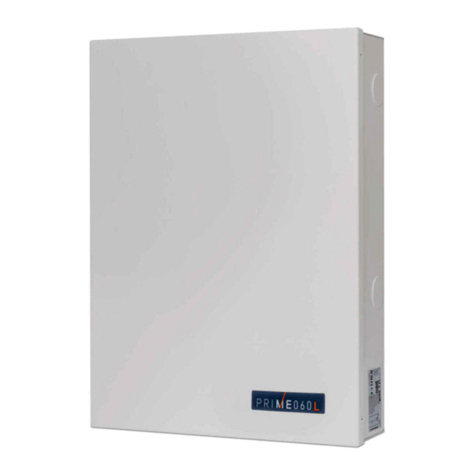
INIM Electronics
INIM Electronics Prime Series User manual

INIM Electronics
INIM Electronics Prime Series User manual
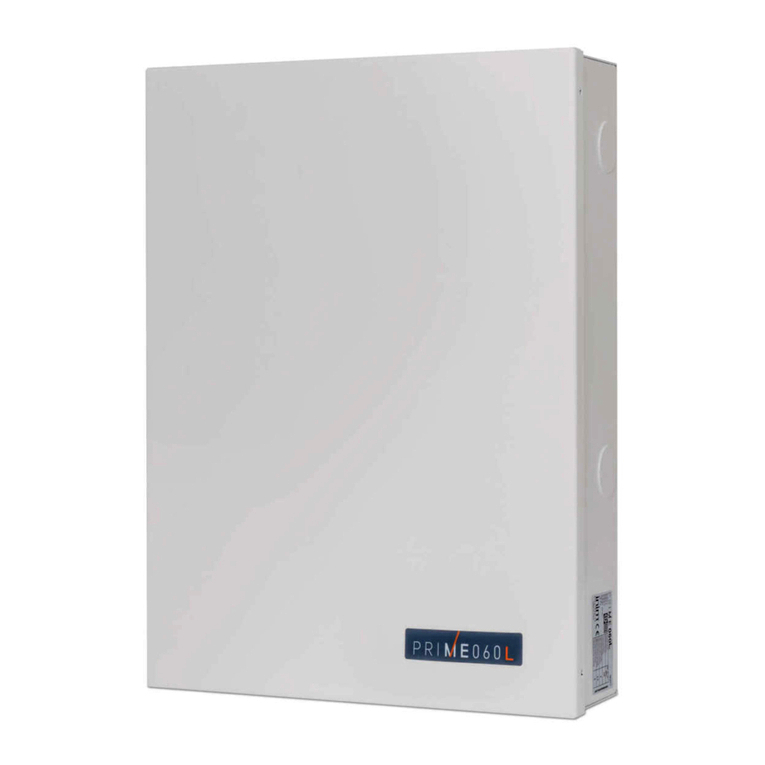
INIM Electronics
INIM Electronics Prime060S User manual

INIM Electronics
INIM Electronics SmartLoop Owner's manual
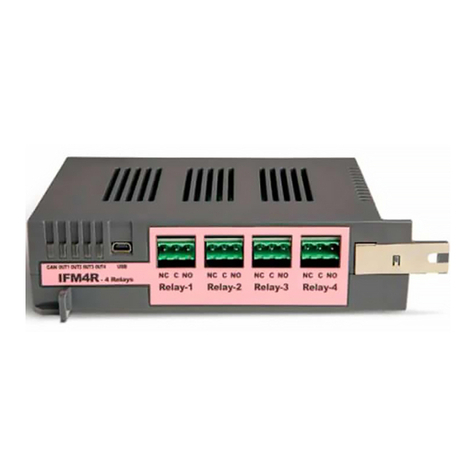
INIM Electronics
INIM Electronics PREVIDIA MAX User manual
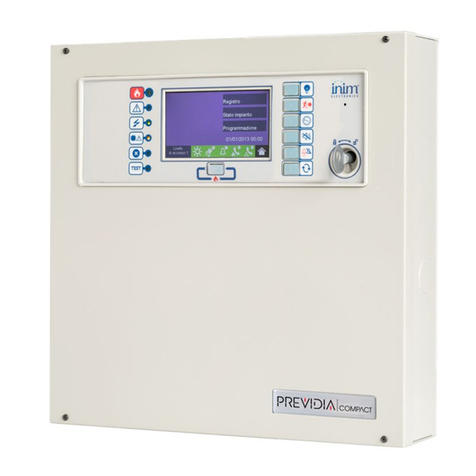
INIM Electronics
INIM Electronics Previdia Compact User manual
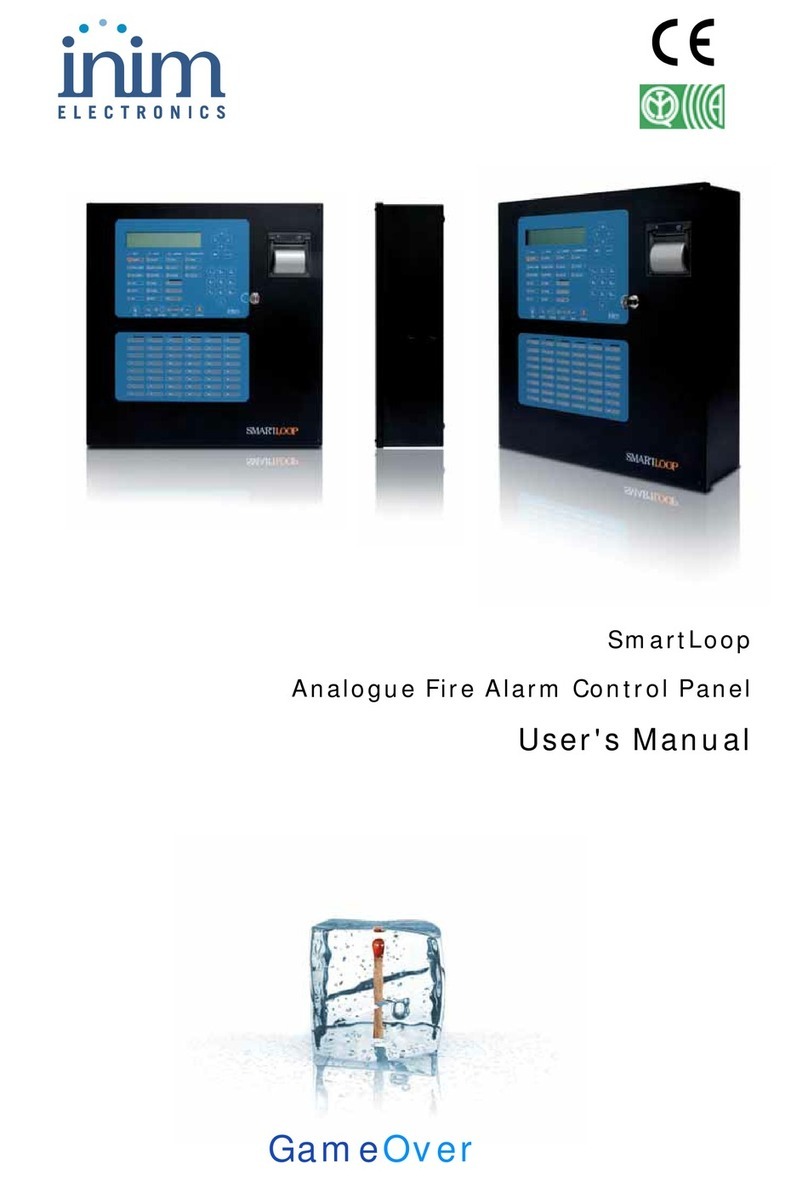
INIM Electronics
INIM Electronics SmartLoop User manual

INIM Electronics
INIM Electronics Previdia Compact User manual
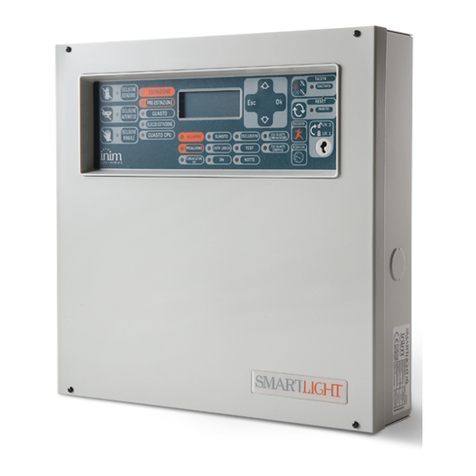
INIM Electronics
INIM Electronics SmartLight User manual

INIM Electronics
INIM Electronics Previdia Compact Quick guide
